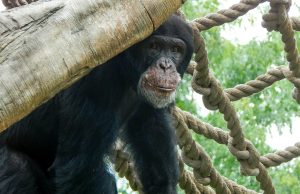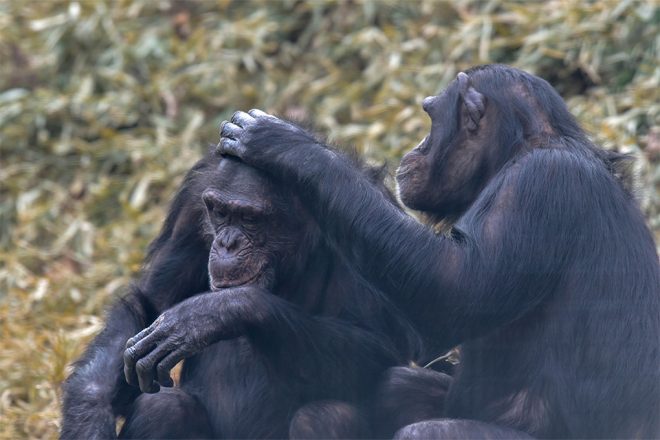By Sarah Evans
“The chimpanzee community is a fusion-fission society,” wrote renowned primatologist Jane Goodall in one of her seminal works, The Chimpanzees of Gombe. At the time of its publication, Goodall had been living among chimpanzees in the sweltering forests of Tanzania for 25 years, learning more about the behavior of our closest primate cousin than anyone prior or since.
Chimpanzees form large, hierarchical groups, or communities, observed Goodall. (A fusion of chimps, so to speak.) Within each community, however, there exist smaller social groups whose members are constantly changing. (A fission of chimps, so to speak.) The fluidity of the smaller groups means that individual chimpanzees are “free at almost all times to join–or to avoid–any other individual” in the community, wrote Goodall. It also means that “it is never possible for a chimpanzee, upon wakening in the morning, to be quite sure who he will encounter during the day.”
Up until now, the Zoo’s chimpanzees have not always had this social experience. They wake and encounter all members of their troop each day, regardless of who chooses to hang out with whom from moment to moment. This is about to change, though, which means that life in the Zoo’s troop is about to get even more interesting. This summer, the six-keeper Chimp Team, led by Area Manager Pam Carter, will introduce “fusion-fission” to the Zoo’s troop.
Group Dynamics
To be honest, “fusion-fission” as a management strategy is often born of necessity in chimp troops. One chimpanzee, for whatever reason, simply cannot with another chimpanzee. Chimp society, like ours, involves friends, enemies, and power struggles, and sometimes you have two chimps that don’t always get along. Rather than remove either chimp from the troop, the alternative is to minimize their interactions and allow other members of the troop to flow freely between groups. This way, relationships, alliances, and freedom of association are maintained, but conflict is averted.
“We are always watching those relationships and coalitions that are forming because that’s a natural part of chimp society,” explains Erin Cantwell, Mammal Collection & Conservation Manager at the Zoo. “It’s our responsibility to read those behaviors appropriately and mitigate any issues, including changing things up with a different management strategy if necessary.”
It’s Complicated
Solving one challenge will almost certainly create new ones because “any time you change one piece of the social equation with chimps, it cascades into everything else,” says Cantwell. Chimp society is complex, with rules of engagement that can be difficult to discern, but the main organizing factor is social rank. An alpha male sits atop the chimp social hierarchy and rules the troop. He ranks #1 and every other male falls in line beneath him. Females form their own hierarchy within the troop, and juveniles usually acquire rank based on that of their mothers. It’s complicated, to say the least.
Chimpanzee life revolves around climbing up and falling down the social ladder. Your position on the ladder matters because it influences your quality of life and chance of survival. Chimpanzees form genuine friendships and preferences for one another, but every interaction is also defined by the social pecking order. “I’m either working to get along with you or I’m working to overpower you, whichever is more likely to improve my status,” says Cantwell, channeling a chimp’s inner thoughts. Needless to say, the social dynamics become even more complex when social groups are in flux.
Managing the Shift
Few zoos would be able to take on a management challenge like this, but the Maryland Zoo is well prepared to do so because of its long history, considerable experience, and staff expertise with chimpanzees. For months now, keepers have been preparing for the shift to fusion-fission by putting different chimps together in small groups and seeing how everyone reacts. When asked whether there has been significant wailing and gnashing of teeth so far (among the chimps, not the keepers), Cantwell laughed and replied “yes, but there’s a bit of wailing on a daily basis anyway. That’s just chimps.”
By early July, the Chimp Team expects to formally institute the new management practice. When you visit the Zoo, you’ll start seeing one group of chimps outside together and another group inside. On any given day, the size and makeup of the groups will vary, depending on choices the chimps themselves make each morning.
Enter Alex
Meanwhile, along with fusion-fission, there is another dramatic twist at play in the Zoo’s chimpanzee troop, and his name is “Alex.” This past spring, 21-year-old Alex, a male chimpanzee, joined the Zoo’s troop from the Potawatomi Zoo in South Bend, Indiana, at the recommendation of the AZA’s Species Survival Plan (SSP) for Chimpanzees. He spent several weeks behind the scenes getting to see and hear the other 11 chimps before actually meeting them. He is now being integrated slowly and carefully into the troop. There is no telling how long the process will take, as chimpanzee introductions are notoriously complex, but one thing is certain: the chimps will take the lead and the keepers will be guided by their behaviors.
“Alex has never been in a big troop before so there could be some culture shock for him,” says Cantwell, “but ultimately we hope he will pair up with Kasoje [the troop’s alpha male] and learn from a dominant male.” Over the coming months, he will also get to know Jack and Louie, the troop’s other two males, as well as the eight females. He will have plenty of time to form his own friendships, alliances, and rivalries, just as all chimps do. “It will be interesting to see how it all plays out,” says Cantwell.
Welcome to the troop!
To read more articles from ZooGram click here!






Share this article